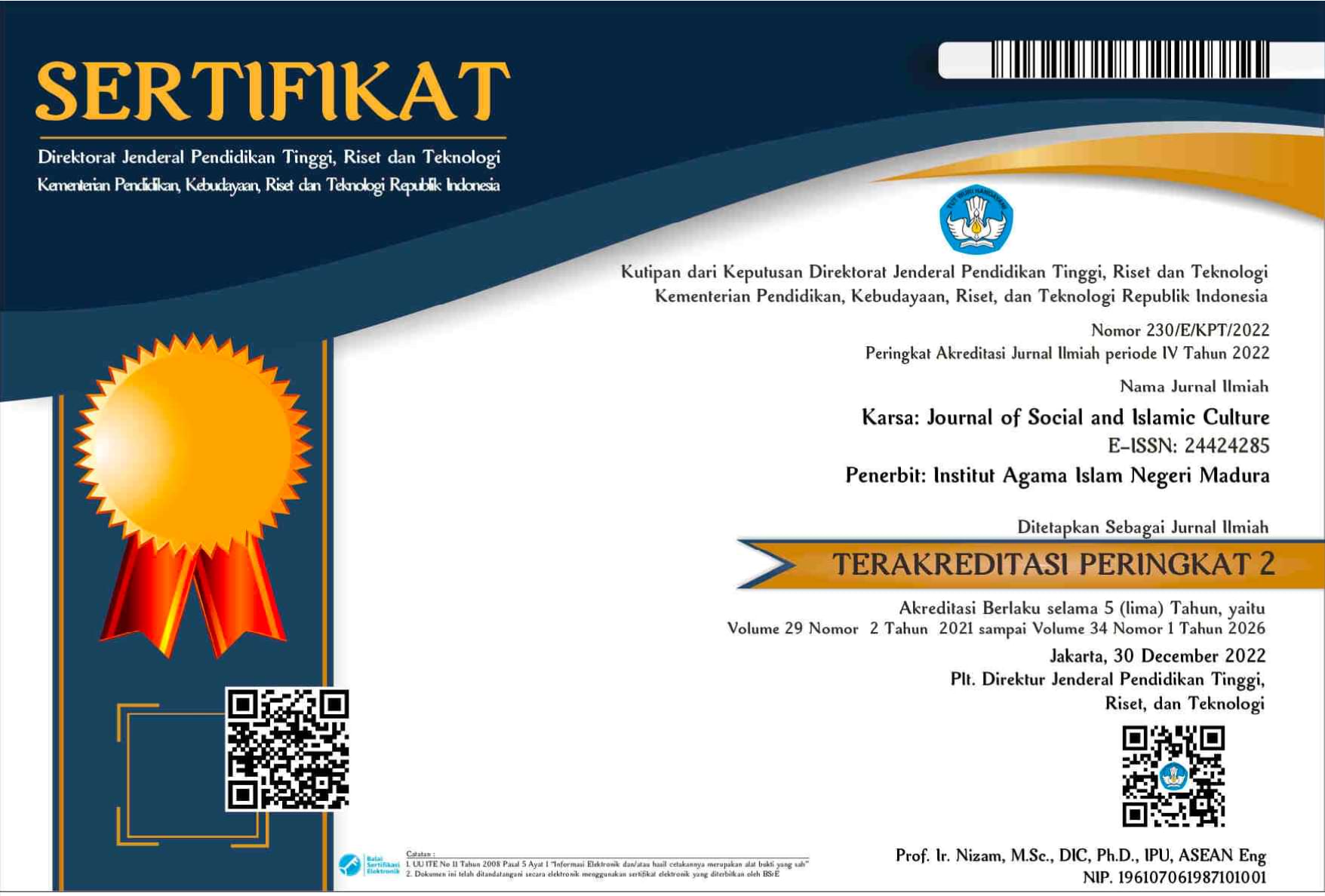Burdah Al-Bushiri Poetry Perception of Kapuas Muslim Scholars
 Abstract views: 436
,
Abstract views: 436
,
 PDF downloads: 508
PDF downloads: 508
Abstract
Downloads
References
Bibliography
Abu Sayem, Md. “Religious Understanding of Nature and Influence of Geographical Environment on Shaping Religious Beliefs and Practices within Christianity and Islam.” Karsa: Journal of Social and Islamic Culture 26, no.2 (December 2018): 195-214. doi: 10.19105/karsa.v26i2.1777.
Adib, Muhammad. Burdah antara Kasidah, Mistis dan Sejarah. Yogyakarta: LKiS, 2009.
Admin. “Sejarah Singkat Kapuas.” Dinas Komunikasi dan Informasi Kabupaten Kapuas. accessed August 8, 2020. https://www.kapu askab.go.id/index.php/profile/sejarah-kapuas.
Admin. ”Data Keagamaan.” Kantor Kementerian Agama Kabupaten Kapuas Kalimantan Tengah. Accessed August 8, 2020. https://kalteng.kemenag.go.id/kapuas/artikel/43066/Data-Umat Beragama-Di-Kabupaten-Kapuas.
Ainussyamsi, F.Y. “Internalisasi Nilai-nilai Sufistik melalui Musika-lisasi Qasidah Burdah.” Educationist: Jurnal Kajian Filosofi, Teori, Kualitas, Dan Manajemen Pendidikan: 3, no. 1 (2009): 49-58. http://file.upi.edu/Direktori/JURNAL/EDUCATIONIST/Vol. _ _III_No._1Januari_2009/07_Fadlil_Yani_A_final. pdf.
Almujalli, H. (2014). The Importance of Ka’b ibn Zuhayr’s Burdah to Classical and Modern Islamic Poetry. Massachusetts: A thesis presented to the Near Eastern and Judaic Studies Department, Graduate School of Arts and Sciences, Brandeis University, Waltham.
Arjum, A. Qaṣīdah Burdah; Busairi’s Poem of the Mantle. Lahore: Zia-ul-Quran Publications, 2000.
Aslan, R. Understanding the Poem of the Burdah in Sufi Commentaries, A thesis at Department of Arab and Islamic Civilizations. Cairo: The American University in Cairo, 2008.
Bachmid, Gayda. “Kitab ‘Burdah’ Karya Sastra Lisan Arab Dalam Perspektif Masyarakat Muslim di Manado, Sulawesi Utara.” Kajian Linguistik 7, no. 1 (2019): 66-84. doi: https://doi.org/ 10.35796/kaling.7.1.2019.25018.
Baharun, M. Burdah Madah Rosul Dan Pesan Moral. Surabaya: Pustaka Progresif, 1996.
Faidi, Ahmad. “Qashidah Burdah sebagai Media Pengobatan Magis-Ekonomis: Studi terhadap Tradisi Pembacaan Qashidah Burdah terhadap Orang Sakit di Desa Sera Timur Kecamatan Bluto Kabupaten Sumenep Propinsi Jawa Timur.” Millati: Journal of Islamic Studies and Humanities 1, no. 1 (Juni 2016): 61-79. doi: 10.18326/millati.v1i1.61-79.
Fuqon, M. Rizalul and Moh. Fery Fauzi. “The Values of Educational Character in the Arabic Temples of Qasidah Burdah by Imam Bushiri.” Izdihar: Journal of Arabic Language Teaching, Linguistics, and Literature 2, no. 1 (April 2019): 67-76. doi: https://doi.org/ 10.22219/jiz.v2i1.8327.
Lubis, M. B. Qaṣīdahs in Honor of the Prophet. Malaysia: Universiti Kebangsaan Malaysia, 1983.
Mahlan. “Nilai-Nilai Spiritual Sufistik Qashidah Burdah Dalam Meningkatkan Religiusitas (Studi Fenomena Di Pondok Pesantren Darussalam Martapura).” Master thesis, IAIN Antasari Banjarmasin, 2015.
Makki, A. Penjelasan Kasidah Burdah, Juz 1 dan 2. Sukabumi: Pesantren Tipar Cimahi, n.y.
Manshur, Fadlil Munawar. “Resepsi Kasidah Burdah Al-Bushiry dalam Masyarakat Pesantren.” Humaniora 18, no. 2 (Juni 2006): 102-113. doi: https://doi.org/10.22146/jh.868.
Manshur, Fadlil Munawwar. “Kasidah Burdah di Antara Sastra Musik Arab.” Tajdid: Jurnal Ilmu-ilmu Agama Islam dan Kebudayaan 14, no. 1 (Maret 2007): 181-206. https://repository.ugm.ac. id/33013/1/2._Kasidah_Burdah_di_Amara_Sastra_Musik_Arab-Fadlil.pdf
Manshur, Fadlil Munawwar. “Polemik Pemaknaan Kasidah Burdah Al-Busiry: Kajian Estetika Negatif.” Adabiyyāt: Jurnal Bahasa dan Sastra 11, no. 2 (Desember 2012): 167-196. doi: https://doi.org/ 10.14421/ajbs. 2012.11201.
Mansoer, M. T. Sajak-Sajak Burdah. Kudus: Menara Kudus, 1974.
Mansoer, Tolchah. Sajak-Sajak Burdah Imam Muhammad Al Bushiri: Terjemahan, Saduran, Pendahuluan. Yogyakarta: Adab Press, 2006.
Masykuri, A. Burdah Imam al-Bushiri Cinta Dari Tepi Sungai Nil. Pasuruan: Pustaka Sidogiri, 2009.
Maulidya M, Riesta, Fitria Sugiatmi and M. Alan Mabruri. “Pengaruh Akulturasi Budaya Masyarakat Loloan Terhadap Struktur Syair Burdah di Bali.” Salingka: Majalah Ilmiah Bahasa dan Sastra 15, no.1 (Juni 2018): 11-15. doi: https://doi.org/10.26499/salingka. v15i01.256.
Muqoddam, Faqihul and Virgin Suciyanti Maghfiroh. “Syncretism of Slametan Tradition As a Pillar of Islam Nusantara.” Karsa: Journal of Social and Islamic Culture 27, no.1 (June 2019): 75-94. doi: https://doi.org/10.19105/karsa.v27i1.1950.
Nihayah, Ulin. “Konsep Seni Qasidah Burdah Imam Al Bushiri Sebagai Alternatif Menumbuhkan Kesehatan Mental.” Jurnal Ilmu Dakwah 34, no.1 (Juni 2014): 295-308. doi: 10.21580/jid.v34.2.488.
Nihayah, Ulin. “Qasidah Burdah Imam Al-Bushiri; Model Alternatif Dakwah Pesantren.” ANNIDA: Jurnal Komunikasi Islam 7, no. 1 (2015): 30-38. doi: https://doi.org/10.34001/an.v7i1.289.
Ramin, Maghfur M. “Pergeseran Makna dan Tujuan Pembacaan Burdah di Desa Jaddung, Pragaan, Sumenep.” Living Islam: Journal of Islamic Discources 1, no. 2 (November 2018): 299-316. doi: https://doi.org/10.14421/lijid.v1i2.1732.
Rosadi, Andri. “Mencari Barokah dan Karomah: Analisis Makna Ziarah Makam di Situ Lengkong Panjalu, Ciamis.” Laporan Penelitian dalam Kegiatan SCME Kemenag RI, 2012.
Rosalinda. “Tradisi Baca Burdah dan Pengalaman Keagamaan Masyarakat Desa Setiris Muaro Jambi.” Kontekstualita: Jurnal Penelitian Sosial Keagamaan 28, no. 2 (2013): 291-307. https://www.neliti.com/publications/145535/tradisi-baca-burdah-dan-pengalaman-keagamaan-masyarakat-desa-setiris-muaro-jambi.
Setiawan, Eko. “Nilai-Nilai Religius Dalam Syair Shalawat Burdah.” LiNGUA: Jurnal Ilmu Bahasa dan Sastra 10, no. 1 (Juni 2015): 1-8. doi: https://doi.org/ 10.18860/ling.v10i1.3027.
Siagian, Sondang. Filsafat Administrasi. Jakarta: Gunung Agung, 1997.
Solikin, A. “Nilai-nilai Spiritual Sufistik Qasidah Burdah dalam Meningkatkan Religiusitas.” Anterior Jurnal 15, no. 1 (Desem-ber 2015): 21–29. doi: https://doi.org/10.33084/anterior.v15i1. 195
Stetkevych, S. P. “From Sīrah to Qaṣīdah: Poetics and Polemics in al-Būṣīrī's ‘Qaṣīdat al-Burdah’ (Mantle Ode).” Journal of Arabic Literature 38, no. 1 (2007): 1-52. https://www.jstor.org/stable/ 4183582?seq=1.
Stetkevych, S. P. “From Text to Talisman: Al-Būṣīrī's ‘Qaṣīdat al-Burdah’ (Mantle Ode) and the Supplicatory Ode.” Journal of Arabic Literature 37, no. 2 (2006): 145-189. https://www.jstor. org/stable/4183564?seq=1.
Surahman, Cucu. “Collating Qaṣīdah Burdah of Al-Buṣīrī: A Living Text between the Traditions and its Manuscripts.” Hayula: Indonesian Journal of Multidisciplinary Islamic Studies 4, no. 2 (Juli 2020): 141-169. doi: https://doi.org/10.21009/hayula. 004.02.01.
Syihabuddin. Analisis Struktur Kasidah Burdah, Intertekstualitas dan Fungsinya bagi Masyarakat Pesantren. Bandung: FBBS, 2012.
The journal operates an Open Access policy under a Creative Commons Non-Commercial Share-Alike license. Authors who publish with this journal agree to the following terms:
- Authors retain copyright and grant the journal right of first publication with the work simultaneously licensed under a Creative Commons Attribution License that allows others to share the work with an acknowledgement of the work's authorship and initial publication in this journal.
- Authors are able to enter into separate, additional contractual arrangements for the non-exclusive distribution of the journal's published version of the work (e.g., post it to an institutional repository or publish it in a book), with an acknowledgement of its initial publication in this journal.
- Authors are permitted and encouraged to post their work online (e.g., in institutional repositories or on their website) prior to and during the submission process, as it can lead to productive exchanges, as well as earlier and greater citation of published work.





















